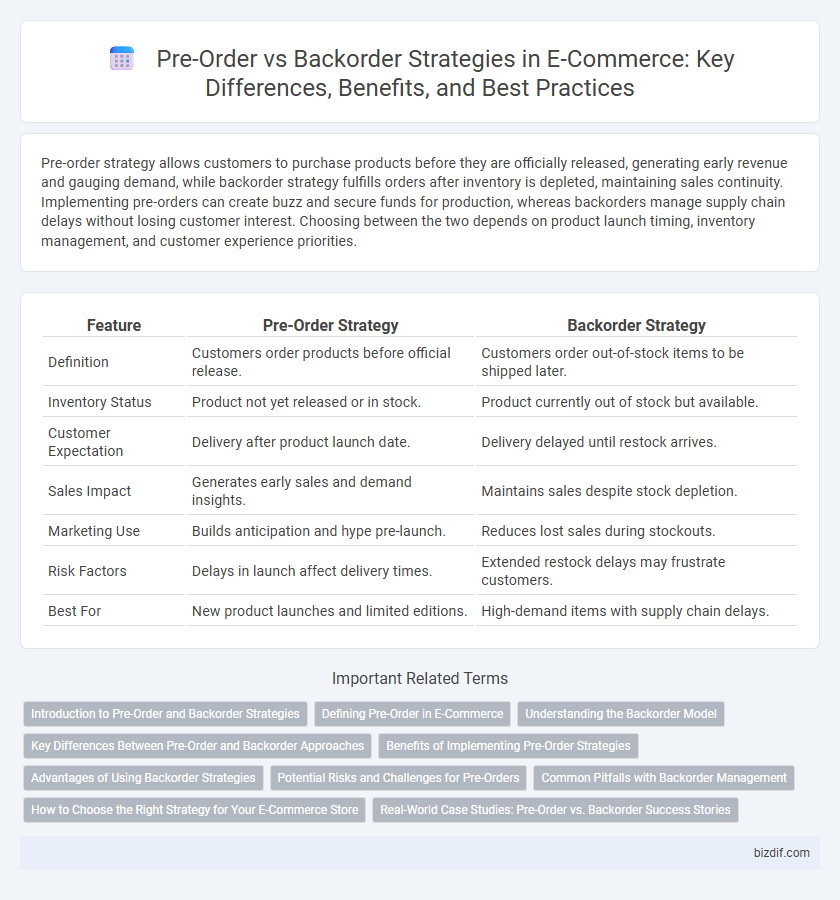Pre-order strategy allows customers to purchase products before they are officially released, generating early revenue and gauging demand, while backorder strategy fulfills orders after inventory is depleted, maintaining sales continuity. Implementing pre-orders can create buzz and secure funds for production, whereas backorders manage supply chain delays without losing customer interest. Choosing between the two depends on product launch timing, inventory management, and customer experience priorities.
Table of Comparison
| Feature | Pre-Order Strategy | Backorder Strategy |
|---|---|---|
| Definition | Customers order products before official release. | Customers order out-of-stock items to be shipped later. |
| Inventory Status | Product not yet released or in stock. | Product currently out of stock but available. |
| Customer Expectation | Delivery after product launch date. | Delivery delayed until restock arrives. |
| Sales Impact | Generates early sales and demand insights. | Maintains sales despite stock depletion. |
| Marketing Use | Builds anticipation and hype pre-launch. | Reduces lost sales during stockouts. |
| Risk Factors | Delays in launch affect delivery times. | Extended restock delays may frustrate customers. |
| Best For | New product launches and limited editions. | High-demand items with supply chain delays. |
Introduction to Pre-Order and Backorder Strategies
Pre-order strategy allows customers to purchase products before they are officially released, generating early demand and securing sales ahead of inventory availability. Backorder strategy enables customers to order items currently out of stock, maintaining sales flow while indicating delayed shipment timelines. Both strategies optimize inventory management and cash flow by balancing supply constraints and customer expectations in e-commerce.
Defining Pre-Order in E-Commerce
Pre-order strategy in e-commerce allows customers to purchase products before they are officially released or back in stock, enabling businesses to gauge demand and secure sales ahead of inventory availability. This approach helps optimize production planning and cash flow by collecting payments or deposits upfront. Unlike backorder, which ships items after current stock is depleted, pre-orders focus on anticipated releases, often accompanied by exclusive offers or limited-edition products.
Understanding the Backorder Model
The backorder strategy enables customers to purchase out-of-stock products with a delayed shipping timeline, improving cash flow and demand forecasting accuracy for e-commerce businesses. This model requires transparent communication about expected delivery dates to maintain customer satisfaction and reduce cancellations. Efficient inventory management systems integrated with real-time stock data are essential to optimizing the backorder process and minimizing fulfillment delays.
Key Differences Between Pre-Order and Backorder Approaches
Pre-order strategy allows customers to purchase products before they are officially released, ensuring demand is captured ahead of time and providing clear launch timelines, while backorder strategy deals with selling items that are temporarily out of stock but expected to be replenished. Pre-orders typically involve fixed release dates and help gauge customer interest, whereas backorders focus on managing inventory shortages and fulfilling existing demand. The key difference lies in timing and inventory status: pre-orders anticipate future stock, whereas backorders respond to current stockouts.
Benefits of Implementing Pre-Order Strategies
Implementing pre-order strategies in e-commerce enhances cash flow by securing customer payments before product launch and improving demand forecasting through early sales data analysis. This approach also strengthens customer engagement by creating anticipation and exclusivity for upcoming products, leading to increased brand loyalty and market competitiveness. Retailers benefit from optimized inventory management, minimizing overstock and stockouts by aligning production closely with confirmed orders.
Advantages of Using Backorder Strategies
Backorder strategies enable e-commerce businesses to maintain sales momentum even when inventory runs out, ensuring customer retention and steady cash flow. They provide real-time demand insights that help optimize inventory forecasting and reduce stockouts in future cycles. Leveraging backorders also enhances customer engagement by offering transparent availability updates, which builds trust and encourages repeat purchases.
Potential Risks and Challenges for Pre-Orders
Pre-order strategies in e-commerce carry potential risks such as inaccurate demand forecasting leading to excess inventory or stockouts, which impact cash flow and customer satisfaction. Delays in production or shipping may cause longer wait times, resulting in increased cancellation rates and negative reviews. Managing customer expectations and ensuring timely communication are critical challenges to maintain trust and prevent reputational damage.
Common Pitfalls with Backorder Management
Backorder management often faces challenges such as inaccurate inventory forecasting, leading to prolonged customer wait times and increased cancellations. Poor communication about backorder status can erode customer trust and damage brand reputation. Failure to prioritize high-demand products in backorder processing results in lost sales opportunities and disrupted supply chain efficiency.
How to Choose the Right Strategy for Your E-Commerce Store
Evaluate your inventory levels, supplier reliability, and customer demand patterns when choosing between a pre-order strategy and a backorder strategy for your e-commerce store. Pre-order allows you to gauge customer interest and secure sales before stock arrives, ideal for new product launches, while backorders let you sell items temporarily out of stock, minimizing lost sales but requiring accurate restock timelines. Prioritize transparent communication about availability and delivery timelines to enhance customer trust and reduce cancellations regardless of the chosen fulfillment approach.
Real-World Case Studies: Pre-Order vs. Backorder Success Stories
Real-world case studies reveal that pre-order strategies boost cash flow and gauge customer demand effectively, exemplified by Apple's iPhone launches, which generate strong initial sales momentum. In contrast, backorder strategies, used by companies like Amazon during peak seasons, help maintain inventory control and customer satisfaction despite stock shortages. Both approaches demonstrate tailored inventory management benefits, with pre-orders driving exclusivity and backorders optimizing supply chain responsiveness.
Pre-Order Strategy vs Backorder Strategy Infographic

 bizdif.com
bizdif.com